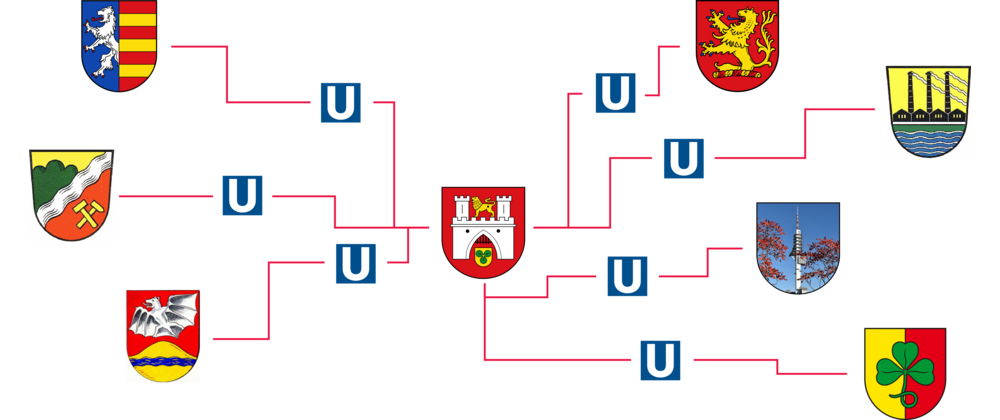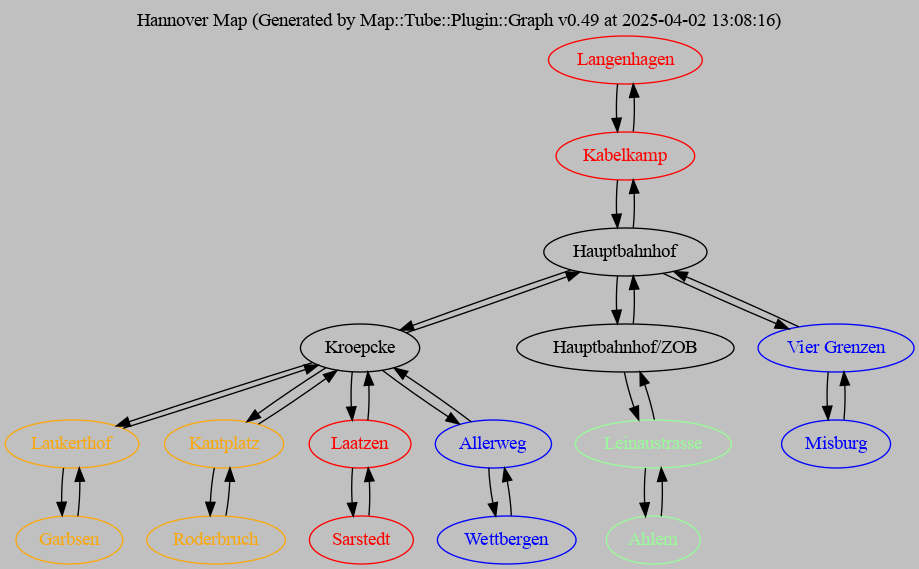Building Map::Tube::<*> maps, a HOWTO: alternative connections

In the previous post, we created a network close enough to reality so that finding routes between stations was possible and sufficiently interesting. In this final post in the series, we’re going to see how to handle indirect connections between stations.
Alternative connections
Not all stations in the Hannover tram network are directly connected. A
good example is the line Linie 10, which starts at the bus station next to
the main train station and has the station name
Hauptbahnhof/ZOB.1 As its name suggests, this station is
associated with the station Hauptbahnhof. Although they’re very close to
one another, they’re not connected directly. You have to cross a road to get
to Hauptbahnhof from the Hauptbahnhof/ZOB tram stop. A routing
framework such as Map::Tube should
allow such indirect connections, thus joining Linie 10 to the rest of the
network.
So how do we connect such indirectly connected stations?
Map::Tube has a solution: the
other_link attribute.
Planning a path
To see this attribute in action, let’s add the line Linie 10 to the
network and connect Hauptbahnhof to Hauptbahnhof/ZOB with an
other_link. Then we can try creating a route from Ahlem (at the end of
Linie 10) to Misburg (at the end of Linie 7) and see if our new
connection type works as we expect. Let’s get cracking!
Here’s the planned list of stations, IDs and links:
| Station | ID | Links |
|---|---|---|
| Ahlem | H15 | H16 |
| Leinaustraße | H16 | H15, H17 |
| Hauptbahnhof/ZOB | H17 | H16 |
Ahlem is the westernmost station, hence it’s the “first” station along
Linie 10. Therefore, it gets the next logical ID carrying on from where we
left off in the map file.
Letting the tests lead the way
As we’ve done before, we drive these changes by leaning on our test suite. We want to have four lines in the network now, hence we update our number of lines test like so:
my $num_lines = scalar @{$hannover->get_lines};
is( $num_lines, 4, "Number of lines in network correct" );
We can test that we’ve added the line and its stations correctly by checking for the expected route. Our routes tests are now:
my @routes = (
"Route 1|Langenhagen|Sarstedt|Langenhagen,Kabelkamp,Hauptbahnhof,Kroepcke,Laatzen,Sarstedt",
"Route 4|Garbsen|Roderbruch|Garbsen,Laukerthof,Kroepcke,Kantplatz,Roderbruch",
"Route 7|Wettbergen|Misburg|Wettbergen,Allerweg,Kroepcke,Hauptbahnhof,Vier Grenzen,Misburg",
"Route 10|Ahlem|Hauptbahnhof/ZOB|Ahlem,Leinaustraße,Hauptbahnhof/ZOB",
);
ok_map_routes($hannover, \@routes);
where we’ve added the expected list of stations for Linie 10 to the end of
the @routes list.
Let’s make sure the tests fail as expected:
$ prove -lr t/map-tube-hannover.t
t/map-tube-hannover.t .. 1/?
# Failed test 'Number of lines in network correct'
# at t/map-tube-hannover.t line 15.
# got: '3'
# expected: '4'
Yup, that looks good. We expect four lines but only have three. Let’s add the line to our maps file now:
{
"id" : "L10",
"name" : "Linie 10",
"color" : "PaleGreen"
}
where I’ve guessed that the line colour used in the Üstra “Netzplan U” is pale green.
A line takes shape
Re-running the tests, we have:
$ prove -lr t/map-tube-hannover.t
t/map-tube-hannover.t .. # Line id L10 consists of 0 separate components
# Failed test 'Hannover'
# at /home/cochrane/perl5/perlbrew/perls/perl-5.38.3/lib/site_perl/5.38.3/Test/Map/Tube.pm line 196.
# Line id L10 defined but serves no stations (not even as other_link)
# Failed test 'Hannover'
# at /home/cochrane/perl5/perlbrew/perls/perl-5.38.3/lib/site_perl/5.38.3/Test/Map/Tube.pm line 196.
# Looks like you failed 2 tests of 14.
Again, we expected this as this line doesn’t have any stations yet. Let’s add them to the map file.
{
"id" : "H15",
"name" : "Ahlem",
"line" : "L10",
"link" : "H16"
},
{
"id" : "H16",
"name" : "Leinaustraße",
"line" : "L10",
"link" : "H15,H17"
},
{
"id" : "H17",
"name" : "Hauptbahnhof/ZOB",
"line" : "L10",
"link" : "H16"
}
This time, we expect the tests to tell us that this line isn’t connected to the network. Sure enough:
$ prove -lr t/map-tube-hannover.t
t/map-tube-hannover.t .. # Map has 2 separate components; e.g., stations with ids H1, H15
# Failed test 'Hannover'
# at
/home/cochrane/perl5/perlbrew/perls/perl-5.38.3/lib/site_perl/5.38.3/Test/Map/Tube.pm line 196.
# Looks like you failed 1 test of 14.
The error message
Map has 2 separate components; e.g., stations with ids H1, H15
means that the line isn’t connected to any of the other lines already present because the map contains separate components.
Consider the alternative
To fix this, let’s change the entry for Hauptbahnhof/ZOB to use the
other_link attribute and see if that helps:
{
"id" : "H17",
"name" : "Hauptbahnhof/ZOB",
"line" : "L10",
"link" : "H16",
"other_link" : "Street:H3"
}
Oddly, the tests still raise an error:
$ prove -lr t/map-tube-hannover.t
t/map-tube-hannover.t .. # Map has 2 separate components; e.g., stations with ids H1, H15
# Failed test 'Hannover'
# at /home/cochrane/perl5/perlbrew/perls/perl-5.38.3/lib/site_perl/5.38.3/Test/Map/Tube.pm line 196.
t/map-tube-hannover.t .. 1/? # Looks like you failed 1 test of 14.
# Failed test 'ok_map_data'
# at t/map-tube-hannover.t line 11.
Oh, that’s right! We’ve only linked Hauptbahnhof/ZOB to Hauptbahnhof;
we need to add the other_link in the other direction as well. We could
have debugged this situation by running bin/map2image.pl and inspecting
the generated image. Yet we’ve seen this issue
before
and can call on experience instead.
We can fix the problem by updating the entry for Hauptbahnhof like so:
{
"id" : "H3",
"name" : "Hauptbahnhof",
"line" : "L1,L7",
"link" : "H2,H8,H12",
"other_link" : "Street:H17"
},
Now the tests still fail, even though we thought we’d fixed everything:
$ prove -lr t/map-tube-hannover.t
t/map-tube-hannover.t .. 1/? Map::Tube::get_node_by_name(): ERROR: Invalid Station Name [Leinaustraße]. (status: 101) file /home/cochrane/perl5/perlbrew/perls/perl-5.38.3/lib/site_perl/5.38.3/Test/Map/Tube.pm on line 1434
# Tests were run but no plan was declared and done_testing() was not seen.
What’s going wrong?
Oh, yeah, the sharp-s (ß) character messes with the routing tests as we saw in the previous article in the series.
Let’s replace ß with the equivalent “double-s” for the Leinaustraße
station. First in the map file:
{
"id" : "H16",
"name" : "Leinaustrasse",
"line" : "L10",
"link" : "H15,H17"
},
and then in the routes tests:
my @routes = (
"Route 1|Langenhagen|Sarstedt|Langenhagen,Kabelkamp,Hauptbahnhof,Kroepcke,Laatzen,Sarstedt",
"Route 4|Garbsen|Roderbruch|Garbsen,Laukerthof,Kroepcke,Kantplatz,Roderbruch",
"Route 7|Wettbergen|Misburg|Wettbergen,Allerweg,Kroepcke,Hauptbahnhof,Vier Grenzen,Misburg",
"Route 10|Ahlem|Hauptbahnhof/ZOB|Ahlem,Leinaustrasse,Hauptbahnhof/ZOB",
);
ok_map_routes($hannover, \@routes);
How did we do?
$ prove -lr t/map-tube-hannover.t
t/map-tube-hannover.t .. ok
All tests successful.
Files=1, Tests=4, 0 wallclock secs ( 0.03 usr 0.00 sys + 0.55 cusr 0.05 csys = 0.63 CPU)
Result: PASS
Success! 🎉
A view from the top
We’ve reached the end of the development phase of the HOWTO. At this point,
the complete test file (t/map-tube-hannover.t) looks like this:
use strict;
use warnings;
use Test::More;
use Map::Tube::Hannover;
use Test::Map::Tube;
my $hannover = Map::Tube::Hannover->new;
ok_map($hannover);
ok_map_functions($hannover);
my $num_lines = scalar @{$hannover->get_lines};
is( $num_lines, 4, "Number of lines in network correct" );
my @routes = (
"Route 1|Langenhagen|Sarstedt|Langenhagen,Kabelkamp,Hauptbahnhof,Kroepcke,Laatzen,Sarstedt",
"Route 4|Garbsen|Roderbruch|Garbsen,Laukerthof,Kroepcke,Kantplatz,Roderbruch",
"Route 7|Wettbergen|Misburg|Wettbergen,Allerweg,Kroepcke,Hauptbahnhof,Vier Grenzen,Misburg",
"Route 10|Ahlem|Hauptbahnhof/ZOB|Ahlem,Leinaustrasse,Hauptbahnhof/ZOB",
);
ok_map_routes($hannover, \@routes);
done_testing();
with the other Perl files remaining unchanged.
The full JSON content of the map file is too long to display here, but if you’re interested, you can see it in the Git repository accompanying this article series.
To get a feeling for what the network looks like, try running
bin/map2image.pl. Doing so, you’ll find a network graph similar to this:

Although the graph doesn’t highlight the indirect link, it does show the connectivity in the entire map and gives us a high-level view of what we’ve achieved.
Taking the indirect route
With our latest map changes in hand, we can find our way from Ahlem to
Misburg:
$ perl bin/get_route.pl Ahlem Misburg
Ahlem (Linie 10), Leinaustrasse (Linie 10), Hauptbahnhof/ZOB (Linie 10, Street), Hauptbahnhof (Linie 1, Linie 7, Street), Vier Grenzen (Linie 7), Misburg (Linie 7)
Wicked! It worked! And it got the connection from Hauptbahnhof/ZOB to
Hauptbahnhof right. Nice!
We can also plan more complex routes, such as travelling from Ahlem to
Roderbruch:
$ perl bin/get_route.pl Ahlem Roderbruch
Ahlem (Linie 10), Leinaustrasse (Linie 10), Hauptbahnhof/ZOB (Linie 10, Street), Hauptbahnhof (Linie 1, Linie 7, Street), Kroepcke (Linie 1, Linie 4, Linie 7), Kantplatz (Linie 4), Roderbruch (Linie 4)
Looking closely, we find that we have to change at Hauptbahnhof and then
again at Kroepcke to reach our destination. Comparing this with the
Üstra “Netzplan
U”
we can see (for the simpler map created here) that this matches reality.
Brilliant!
Let’s commit that change and give ourselves a pat on the back for a job well done!
$ git ci share/hannover-map.json t/map-tube-hannover.t -m "Add Linie 10 to network
>
> The most interesting part about this change is the use of other_link
> to ensure that Hauptbahnhof/ZOB and Hauptbahnhof are connected to one
> another and hence Linie 10 is connected to the rest of the network
> and routes can be found from Linie 10 to other lines."
[main bc34daa] Add Linie 10 to network
2 files changed, 29 insertions(+), 3 deletions(-)
Here, at the end of all things
Welcome to the end of the article series! Thanks for staying until the end. 🙂
Wow, that was quite a lot of work! But it was fun, and we learned a lot along the way. For instance, we’ve learned:
- how to start a Perl module from scratch,
- how a
Map::Tubemap is structured, - how to build a railway network using
Map::Tubein a test-driven manner, - how to use Git as a natural element of development flow,
- how to visualise the graph of a
Map::Tubenetwork, - and how to find routes from one station to another.
This discussion has hopefully given you the tools you need to create your
own Map::Tube map. There’s so much more you can do with Map::Tube, so
it’s a good idea to spend some time browsing the
documentation. Therein you will find
many nuggets of information and hints for ideas of things to play with.
I wish you the best of luck and have fun!
-
For those wondering who don’t speak German: Hauptbahnhof means “main train station” or equivalently “central train station”. ZOB is the abbreviation of Zentralomnibusbahnhof, which looks like it literally translates as “central omnibus train station”, but really means “central bus station”. ↩︎
Tags
Feedback
Something wrong with this article? Help us out by opening an issue or pull request on GitHub






